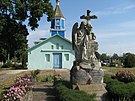Kobryn
Kobryn
| |
|---|---|
 Downtown Kobryn,c.2010 | |
| Coordinates:52°13′0″N24°22′0″E/ 52.21667°N 24.36667°E | |
| Country | Belarus |
| Region | Brest Region |
| District | Kobryn District |
| First mentioned | 1287 |
| Government | |
| • Chairman | Mikhail Grishkevich |
| Area | |
• Total | 26 km2(10 sq mi) |
| Population (2024)[1] | |
• Total | 52,635 |
| • Density | 2,000/km2(5,200/sq mi) |
| Time zone | UTC+3(MSK) |
| Postal code | 225301—225306, 225860 |
| Area code | +375 1642 |
| License plate | 1 |
| Website | Official website(in Russian) |
Kobryn(Belarusian:Кобрын;Polish:Kobryń;Lithuanian:Kobrynas;Ukrainian:Кобринь;Yiddish:קאָברין) orKobrin(Russian:Кобрин), is a town inBrest Region,Belarus.It serves as the administrative center ofKobryn District.[1]It is located in the southwestern corner of Belarus, where theMukhavetsriver andDnieper–Bug Canalmeet. The town lies about 52 kilometres (32 mi) east of the city ofBrest.As of 2024, it has a population of 52,635.[1]
History
[edit]In the early times, it was inhabited by the ancientBalticYotvingiantribe. At various times, the city belonged toKingdom of Galicia–Volhynia,theGrand Duchy of Lithuania,thePolish–Lithuanian Commonwealth,theRussian Empire,theSecond Polish Republic,theByelorussian SSR,and theRepublic of Belarus.
Middle Ages and early modern era
[edit]
In the 10th century, the area became part of the emergingPolish stateunder first rulerMieszko I of Poland.[2]Later, the area was part of theKievan Rus'and theKingdom of Galicia–Volhynia.[2]Kobryn was first mentioned in 1287.[2]In the early 14th century the town formed part of theGrand Duchy of Lithuania,after theUnion of Krewo(1385) in thePolish–Lithuanian Union.It became the capital of a feudal principality within the Polish–Lithuanian realm, existing from 1387 to 1518.[2]In 1500, princess Anna Kobryńska founded the Catholic church of the Assumption of the Virgin Mary.[2]After 1518, Kobryn was ruled by QueenBona Sforza,who contributed to its development and visited it several times.[2]
A seat of apowiat,in between 1589 and 1766 it was aroyal cityof thePolish–Lithuanian Commonwealth,located onMagdeburg Law.This allowed for a large number ofJewsto settle in the area following the 16th century. The Jewish population in 1900 was 6,738.[3]In Kobryń was held the countySejmikof the Mozyrz County during theRussian occupationofMozyrzin 1659.[4]In the years 1774–1784 a canal was built connecting theMukhavets Riverwith thePina River,named theRoyal Canalafter Polish KingStanisław August Poniatowski,who opened it, and as a result a water route was created connecting theBaltic Seaand theBlack Sea.[2]
Late modern era
[edit]
After thePartitions of Polandof 1795, the town was annexed byImperial Russia.Catherine IIgave Kobryn to Field MarshalAlexander Suvorovfor his war merits, especially for the suppression of the PolishKościuszko Uprising.[2]At Kobrinthe first significant Russian victory over the French occurred during theFrench invasion of Russia.After the unsuccessfulJanuary Uprisinganti-Polish repressions intensified: estates were confiscated, insurgents and landowners weredeportedtoSiberia(see:sybirak) and a ban on land acquisition by ethnicPoleswas introduced.[2]Kobryn was occupied byGermanyduringWorld War I.
Kobryń came under Polish control in February 1919,[5]four months after the reestablishment ofindependent Poland.[2]During thePolish–Soviet Warit was the site of the victoriousBattle of Kobryńin September 1920. Polish rule was confirmed under the terms of theTreaty of Rigain 1921 and Kobryń became a seat of a powiat within thePolesie Voivodeship.After the war, crafts, small industry and trade developed again, and small factories were established.[2]In 1923, the StateGymnasiumwas founded, which three years later received the name ofMaria Rodziewiczówna,a Polish writer living nearby, who co-financed the construction of the school.[2]
World War II and recent times
[edit]
During the 1939Invasion of Poland,Kobryn was the battle scene of theBattle of Kobryńbetween thePolish 60th Infantry Divisionof ColonelAdam Eplerand the German 19th Panzer Corps of GeneralHeinz Guderian.After three days of fighting, the Poles withdrew southwards and the Germans entered the town, which they three days later handed over to the Soviets in accordance with theMolotov–Ribbentrop Pact.On 14 November 1939, Kobryn was incorporated into theByelorussian SSR.
From 23 June 1941 until 20 July 1944, Kobryn wasoccupied by Nazi Germanyand administered as a part of the Generalbezirk Wolhynien-Podolien ofReichskommissariat Ukraine.During the latter period, the majority of Jewish inhabitants were first amassed in a ghetto and then murdered by the Nazis in their extermination camps.
Two Polish priests,The ReverendWładysław Grobelny and Jan Wolski from Kobryń near Brześć, arrested for helping the Jews, were executed on October 15, 1942 together with a number of Jews from the Brześć ghetto.[6][7]
In 1944, the town was captured by theRed Army.Since 1991, it is a part of theRepublic of Belarus.
Notable people
[edit]- Enrique Oltuski(1930 – 2012), Cuban revolutionary and politician.
- Gedaliah Alon(1901–1950), Israeli Historian
- Samuel Epstein(1919–2001), Polish-Canadian-American Geo-chemist
- Oscar Zariski(1899–1986), Mathematician.
Sights
[edit]Among the historical monuments of the city are the Catholic Church of the Dormition,BaroqueMonastery of the Transfiguration, a park founded byAntoni Tyzenhauzin 1768, the Orthodox church of St. Alexander Nevsky, the building of the pre-war PolishMaria RodziewiczównaState Gymnasium, the building of the pre-war town hall and the Catholic cemetery, where the family of the Polishnational poetAdam Mickiewiczis buried.
-
Church of the Dormition
-
Monastery of the Transfiguration
-
Church of St. Alexander Nevsky
-
Maria RodziewiczównaState Gymnasium building
-
Former town hall
-
Grave of the Mickiewicz family at the Catholic cemetery
References
[edit]- ^abc"Численность населения на 1 января 2024 г. и среднегодовая численность населения за 2023 год по Республике Беларусь в разрезе областей, районов, городов, поселков городского типа".belsat.gov.by.Archived fromthe originalon 2 April 2024.Retrieved11 June2024.
- ^abcdefghijklBohdan Miłaczewski."Zarys dziejów ziemi kobryńskiej i jej mieszkańców".Echa Polesia(in Polish).Retrieved7 October2019.
- ^JewishGen.org
- ^Wojciech Kriegseisen,Sejmiki Rzeczypospolitej szlacheckiej w XVII i XVIII wieku,Warszawa 1991, p. 33
- ^Lech Wyszczelski,Wojna polsko-rosyjska 1919–1920.Wyd. 1. Bellona, Warszawa, 2010, p. 56, 58
- ^Zajaczkowski, Waclaw (1988).Martyrs of Charity: Christian and Jewish Response to the Holocaust.St. Maximilian Kolbe Foundation. p. 164.ISBN0945281005.
- ^"ks. Władysław Grobelny, wikariusz z parafii w Kobryniu | Pamięć i Tożsamość | MIĘDZYNARODOWE CENTRUM INFORMACYJNE".pamiecitozsamosc.pl.Retrieved2019-06-12.
Further reading
[edit]- T.A.Khvagina (2005)POLESYE from the Bug to the Ubort,Minsk,Vysheysha shkola,ISBN978-985-06-1153-6(in Belarusian, Russian and English)
- Ye.N.Meshechko, A.A.Gorbatsky (2005)Belarusian Polesye: Tourist Transeuropean Water Mains,Minsk. (in Russian, English and Polish) Minsk, Vysheysha shkola,ISBN985-06-1153-7.










